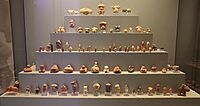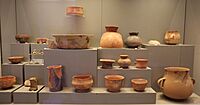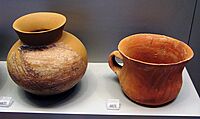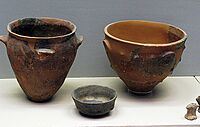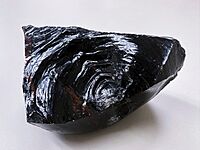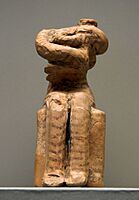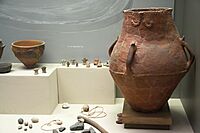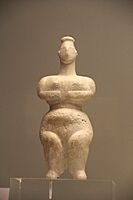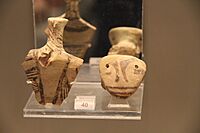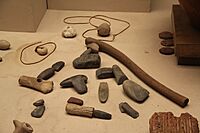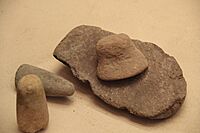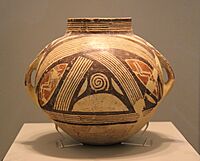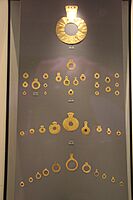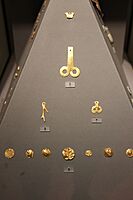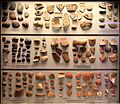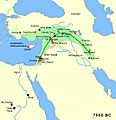Neolithic Greece facts for kids
| Period | Neolithic Europe |
|---|---|
| Dates | c. 7000 – c. 3200 BC |
| Major sites | Nea Nikomedeia, Sesklo, Dimini, Franchthi Cave, Athens, Knossos, Milos |
| Characteristics | Socioeconomic and architectural developments |
| Preceded by | Balkan Mesolithic, Pre-Pottery Neolithic B |
| Followed by | Sesklo culture, Cycladic culture, Minoan civilization, Helladic period, Cardium pottery, Starčevo culture, Eutresis culture, Korakou culture, Tiryns culture |
Neolithic Greece is a time in Greek history when people started farming and raising animals. This period began around 7000 to 6500 BC and ended about 3200 BC. During this time, many important changes happened. People learned to farm and raise livestock. They also built new types of houses, created beautiful art, and made better tools. Neolithic Greece is part of the Prehistory of Southeastern Europe.
Contents
- What is the Neolithic Period in Greece?
- Life in Pre-Pottery Neolithic Greece (6800–6500 BC)
- Early Neolithic Period (6500–5800 BC)
- Middle Neolithic Period (5800–5300 BC)
- Late Neolithic Period (5300-4500 BC)
- Final Neolithic Period (4500–3200 BC)
- Was There Warfare in Neolithic Greece?
- Who Were the Early Farmers of Europe?
- Images for kids
- See also
What is the Neolithic Period in Greece?
The "Neolithic Revolution" was a big change when people started farming instead of just hunting and gathering. This change reached Europe between 7000 and 6500 BC. Farmers from the Near East came to Greece. They likely traveled from Anatolia by sailing between the islands in the Aegean Sea.
Archaeologists have divided the Neolithic period in Greece into six main parts:
| Period | Approximate Date |
|---|---|
| Pre-Pottery (or Aceramic) | 6800–6500 BC |
| Early Neolithic | 6500–5800 BC |
| Middle Neolithic | 5800–5300 BC |
| Late Neolithic I | 5300–4800 BC |
| Late Neolithic II | 4800–4500 BC |
| Final Neolithic (or Chalcolithic) | 4500–3200 BC |
Life in Pre-Pottery Neolithic Greece (6800–6500 BC)
This first part of the Neolithic period is called "Pre-Pottery" because people had not yet started making clay pots. Their economy was based on farming and raising animals.
Early Settlements and Daily Life
People lived in small communities of 50 to 100 individuals. Their homes were often simple huts partly dug into the ground. Examples of these early settlements are found in places like Argissa and Franchthi Cave.
They grew different crops like einkorn, emmer wheat, barley, lentils, and peas. They also went fishing and hunting. For animals, they raised cattle, pigs, sheep, dogs, and goats. People made tools from flint and obsidian (a type of volcanic glass). They also created jewelry from clay, seashells, bone, and stone.
Knossos and Milos
The famous site of Knossos on Crete has a very long history. The first Neolithic settlements there began around 6500-7000 BC. Archaeologists believe that early Neolithic people came to this area, possibly from Western Anatolia, and built their first communities on a local hill.
The volcanic island of Milos was important for its obsidian. This material was used to make tools and weapons. People visited Milos from the Mesolithic period (9000–7800 BC) until the late Neolithic. Obsidian from Milos was traded far and wide across the Aegean Sea, mainland Greece, and even to Egypt. There is no evidence that people lived on Milos permanently until much later, around 4000 BC. Groups likely came to the island just to collect obsidian.
Early Neolithic Period (6500–5800 BC)
After the Pre-Pottery period came the Early Neolithic. People still farmed and raised animals. Settlements continued to be made up of simple, one-room huts. Each community had about 50 to 100 people, usually an extended family or clan.
New Technologies and Customs
During this time, people learned how to make and fire clay pots successfully. They also had specific ways of burying their dead. These included burying bodies in simple pits, burning bodies (cremation), collecting bones, and using cemeteries.
Middle Neolithic Period (5800–5300 BC)
The Middle Neolithic period brought new ways of building houses.
Building Better Homes
Houses were now built with stone foundations. A new type of house, called a "megaron-type" dwelling, became common. These were rectangular, one-room houses with open or closed porches.
Another special house type was the "Tsangli-type" house, named after the settlement of Tsangli. These houses had two inner supports on each side to hold up the roof. These supports also helped divide the house into different areas for things like storage, cooking, and sleeping.
Art and the End of the Period
In art, a swirling pattern called the "meander-labyrinth motif" was seen on seals and jewelry. This pattern was more common in the Early Neolithic but still appeared in the Middle Neolithic.
The Middle Neolithic period ended with some settlements being destroyed by fire. Places like Sesklo were abandoned, while others, like Tsangli-Larisa, were quickly rebuilt.
-
Torso of woman with hands on chest, small terracotta, Sesklo culture, Neolithic, 6th–5th millennium BC
-
Findings from Sesklo, Neolithic Period, c. 5300 BC
Late Neolithic Period (5300-4500 BC)
The Late Neolithic period saw settlements grow and farming become even more important.
Late Neolithic I (LNI)
During this time, people cleared bushes and wooded areas. This made more land available for farming and for animals to graze. New crops like bread wheat, rye, millet, and oat were grown. Food was usually cooked in hearths and ovens inside the houses. Sheep and goats were raised not just for meat, but also for their wool, which was used to make clothes.
Communities grew to 100–300 people, organized into nuclear families. Houses were large, rectangular "megaron-type" buildings with wooden frames and stone foundations. Many settlements were surrounded by ditches, 1.5–3.5 meters deep and 4–6 meters wide. These ditches likely protected against wild animals and marked the settlement's boundaries.
Late Neolithic II (LNII)
After Late Neolithic I, life in the settlements continued much the same. Economic and social life remained steady.
-
Sesklo and Dimini, Late Neolithic Pottery 5300-4500 BC. Greek Prehistory Gallery, National Museum of Archaeology, Athens, Greece.
-
Clay vase with colorful decoration, Dimini, Magnesia, Late or Final Neolithic (5300-3300 BC).
Final Neolithic Period (4500–3200 BC)
The Final Neolithic period was a time of change. It marked the shift from a farming economy to one that used metals. This led into the Early Bronze Age.
The Start of Metal Use
This change happened slowly. People in Greece started to get bronze and copper from other places. They learned basic ways to work with bronze, skills that first came from Asia Minor. This shows they had connections with other cultures.
Neolithic settlements were also found on the islands of Alimia and Rhodes. On Alimia, a settlement on a mountain offered a great view and protection. Archaeologists have found ruins of stone buildings there.
The Eutresis culture developed at the end of the Final Neolithic. It was based on the earlier Neolithic culture of central and southern Greece and lasted into the Early Helladic II period.
Society in the Final Neolithic
In the late Neolithic communities, there were clear differences between social groups. There were free people and slaves. This system continued into the early Mycenaean period.
Was There Warfare in Neolithic Greece?
Archaeological findings suggest that there might have been conflicts during the Neolithic period in Greece.
The Destruction of Sesklo
The remains of Sesklo show signs of fire and destruction. This suggests that there was armed conflict. Some people think that Dimini was responsible for destroying Sesklo, but other reasons for the fire are possible.
Evidence from Bones
Bones found in Alepotrypa cave in southern Greece show injuries that could be related to warfare. Some individuals had many broken bones, though most of these injuries were not deadly.
Fortifications and Defenses
Both Dimini and Sesklo had walls and strong points. Simple defenses like small walls and ditches were common in many Neolithic settlements across Greece. This shows that people faced dangers and had some basic military knowledge.
For example, the settlement of Nea Nikomedeia had two circular ditches. Makriyalos had two lines of V-shaped ditches, with the inner one about 4 meters deep and strengthened by small stone walls. The strongest defenses were found at Dimini and Sesklo. Sesklo's main area (acropolis) was surrounded by a 1.5-meter-thick wall with easily defended gates. Dimini's acropolis also had walls with narrow gateways around a small area.
Who Were the Early Farmers of Europe?
Scientists have studied the DNA from ancient human remains to learn about the people of Neolithic Greece.
Genetic Studies and Migration
A study in 2016 looked at DNA from two Mesolithic (earlier period) samples from Theopetra Cave in Greece. It also looked at five Neolithic samples from both sides of the Aegean Sea. Three were from northern Greece (Revenia, Paliambela, Kleitos) and two from northwestern Anatolia (Barcın).
The study showed that farming spread in Europe because farmers themselves moved, not just because ideas were shared. These early farmers from the Aegean region were directly related to Neolithic farmers across Europe. All of them originally came from farming communities in western Anatolia.
The movement of these Anatolian farmers into Greece likely started by the mid-8th millennium BCE. The DNA of the Mesolithic Greek samples showed a link to Neolithic farmers across Europe. Also, the DNA of the five Neolithic samples matched typical DNA groups of central European Neolithic farmers and modern Europeans. This suggests a migration of early European farmers from the northern Aegean into and across Europe.
Connecting Ancient Greeks to Modern Greeks
Another study in 2017 looked at DNA from 10 Minoans and 4 Mycenaeans. It found that both groups shared at least 75% of their DNA with the Neolithic farmers of western Anatolia and the Aegean. These farmers are known as Early European Farmers. The study also showed that modern Greeks are similar to the Mycenaeans, but their ancient Neolithic ancestry has mixed with other groups over time.
Images for kids
See also
- Neolithic Europe
- Prehistory of Southeastern Europe
- Neolithic Crete
- Pelasgians
- Asphendou Cave petroglyphs


